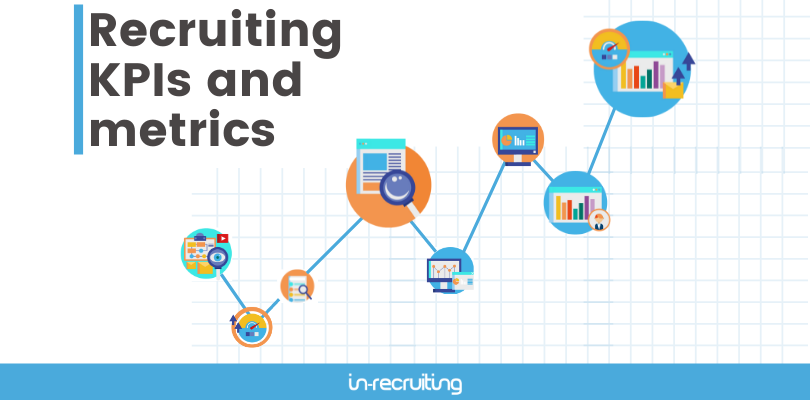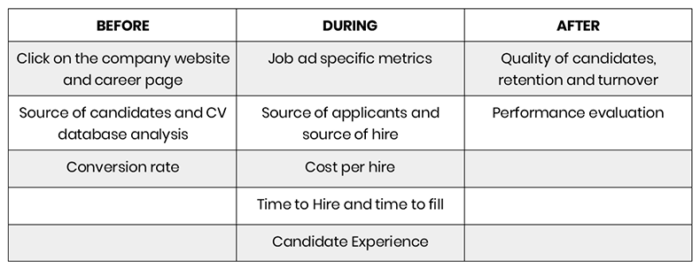
10 recruiting KPIs and metrics every recruiter should keep an eye on
In an ideal HR world, when a new search for personnel begins, the recruiter writes and publishes the perfect ad, receives qualified applications in line with the Job Position and finds, in a short time and at low cost, exactly the candidate he was looking for.
In reality, things are a bit more complex and don’t always go as expected. Recruiters write the ads, publish them on the right platforms and wait to receive the first applications. At this point, it can take a long time before the first CVs are received; hundreds of CVs are received, but none of the profiles match the requirements of the ad; or even the right candidate is found in a short time, unfortunately leaves the company shortly after being hired.
In this case, it’s a good idea to take a closer look at what’s going on. In order to correct the process, the recruiter must rely on reliable data and parameters. Therefore, we have identified 10 recruiting KPIs and metrics that every recruiter should keep under control to improve or refine their recruiting activities.
KPIs and recruiting metrics: what they are and what they are for
KPIs (Key Performance Indicators) and metrics are essential in the HR industry to assess the effectiveness of your recruiting strategies. These indicators and metrics allow you to measure the strengths and weaknesses of your recruiting strategy, monitor the results of the recruiting process and, if necessary, plan corrections and changes. By monitoring these metrics, therefore, it is possible to control the progress and effectiveness of the selection process in order to achieve the objectives of Talent Acquisition.
10 KPIs and metrics for more effective recruiting

In the list of top recruiting KPIs and metrics that every recruiter and HR team should monitor to increase the ROI and effectiveness of recruiting, we’ve included metrics that are relevant before, during, and after the recruiting process.
Many of these can be easily analyzed if you manage your search and selection process with an Applicant Tracking System (ATS) such as In-recruiting. A special section of the software is dedicated to reports and statistics to provide a comprehensive analysis of the performance of key recruiting activities and metrics.
1. Clicks on the company website and career page
Tracing the number of clicks on your website and on the ‘Work with us’ page, specifically, allows you to have a concrete idea of the amount of people interested in your company. In this sense, identifying which ad on the career page has the highest percentage of openings, allows you to have more information on the type of target that intercepts our page.
2. Source of candidates and CV database analysis
This aspect is very important because it allows us to analyze the type of audience that could come into contact with the ad. We are not only talking about candidates who are actively looking for a job or who want to join our team, but also about people who have established a link with the company by following the social profiles, reading the blog, subscribing to the newsletter, etc.. Considering that candidates may come from different channels, it is good to have a centralized database to collect all CVs. This is the case with In-recruiting, which, as a personnel management software, allows you to monitor the composition of the database to know the scope and characteristics of the candidates, even in certain periods. Knowing what kind of candidates respond to job ads is essential: it means that the company is careful to intercept talented candidates and in line with its ads.
3. Conversion Rate
A very low application conversion rate is not a good sign! This means that only a few candidates finish the screening and interviewing after submitting their CV. Why? Among the most well-known causes, a long and complex application form could definitely cause candidates to abandon the process before finishing. With the entry of artificial intelligence in the HR industry, this can easily be solved by introducing systems like Inda (Intelligent Data Analysis) that allow automatic screening of application forms.
4. Job ad specific metrics
To evaluate the performance of a job ad, several factors can be analyzed: the number of views of the ad, the channels it was posted on, the number of applications and where they came from, the number of interviews conducted, etc. These and other elements are useful in measuring the success of a job ad or understanding what went wrong. This makes it easier to identify the error and take action to avoid it in future searches.
5. Source of applicant and source of hire
As mentioned in the previous point, it is important to know where the best candidates are coming from and which publication channel is most functional for your recruiting needs. Among the channels used to disseminate the job ad, it is possible to monitor the source of applicants, to recognize which channel brought in more CVs, which one brought in more candidates in line with the current search, and also which one was less productive. The analysis of this data allows the recruiter to evaluate how to manage the company’s budget, which channels to focus on and whether to invest in the purchase of software that allows multiposting.
6. Time to hire and time to fill
Time to hire and time to filll have very clear effects. Respectively, they indicate the time elapsed between publication of the job offer and recruitment (time to fill), and the time from registration to the ad to the final hiring of the candidate (time to hire). By analyzing recruiting time, we can understand how long it takes to close a job search and how much time the candidate spends in the Hiring Pipeline. These considerations highlight the slowness of the process or its excessive speed that, in both cases, can compromise the success of the selection.
7. Cost per hire
This refers to the costs necessary to fill a vacant position: from the payment of recruiters or the agency to which the search is entrusted, to the costs of publishing paid advertisements or using recruiting software. Cost analysis is a very dedicated subject: incorrect and unthoughtful management of the budget would penalize the company and the quality of the resources hired.
8. Candidate Experience
Candidates who experience the selection process in a positive way can only do the company good. First of all, a positive candidate experience influences the company’s reputation and credibility; secondly, candidates feel valued and this only increases engagement. On the other hand, slow and cumbersome processes, lack of attention to the candidate, non-existent feedback, detachment and disinterest are all factors that detract from candidate engagement.
9. Quality of candidates, retention and turnover
The quality of hiring is closely linked to the candidate experience and the candidate’s life in the company after hiring. The attention and respect shown during the selection process must be confirmed in the period immediately following hiring (and hopefully beyond). Choosing the right candidate, in fact, also means finding one who recognizes himself or herself in the company’s culture. While this promotes retention, it can also happen that the hired candidate decides to leave the company after a short time. In this sense, it is good to know the reasons for turnover and correct them.
10. Performance evaluation
The value of the candidate continues even after he has been hired. As the employee joins the company, it is good to be aware of the improvement and achievement of their goals. It will be a further confirmation that the choice has fallen on the right candidate and that the recruiting strategy has been successful.

Digital Marketing presso Inrecruiting